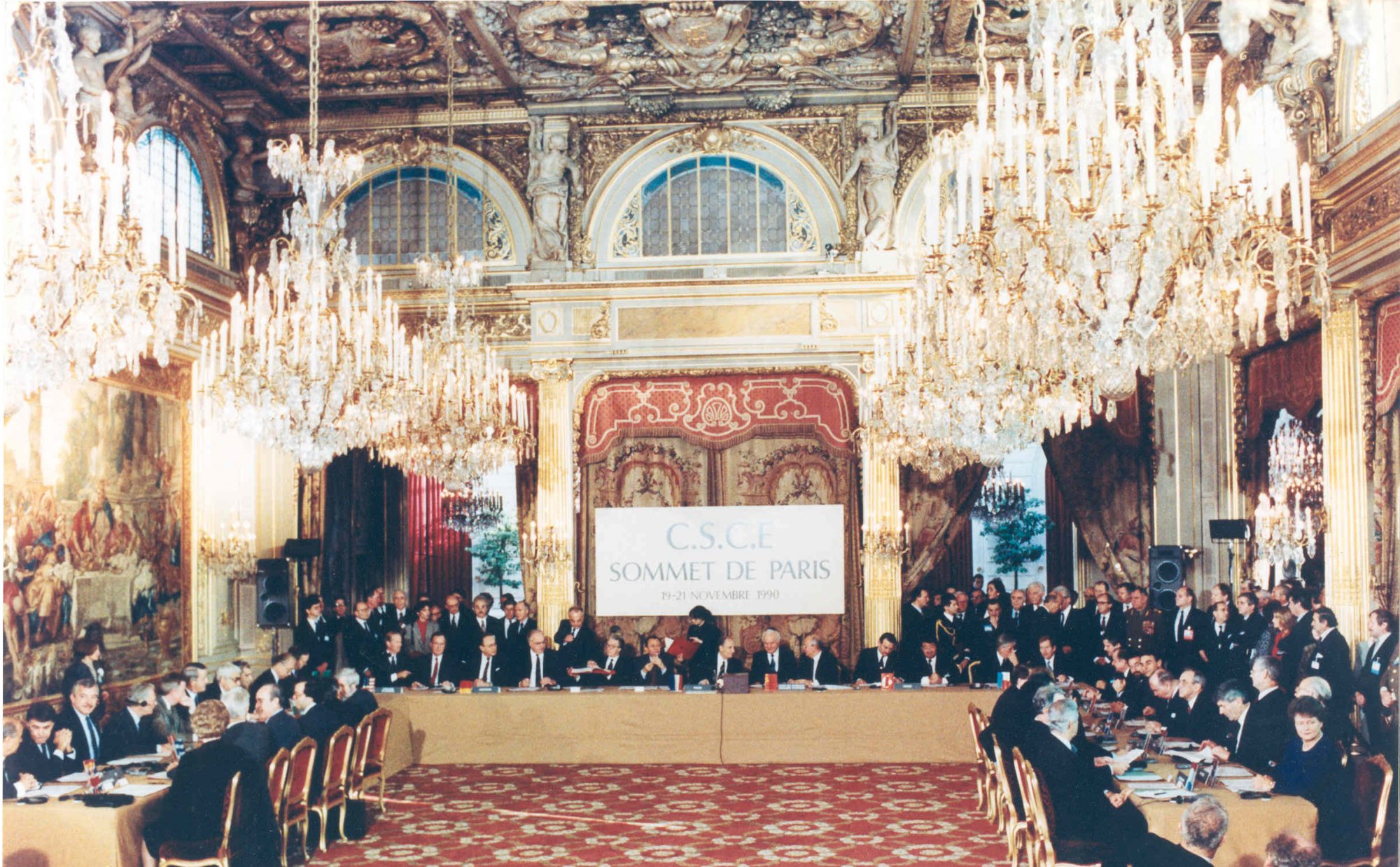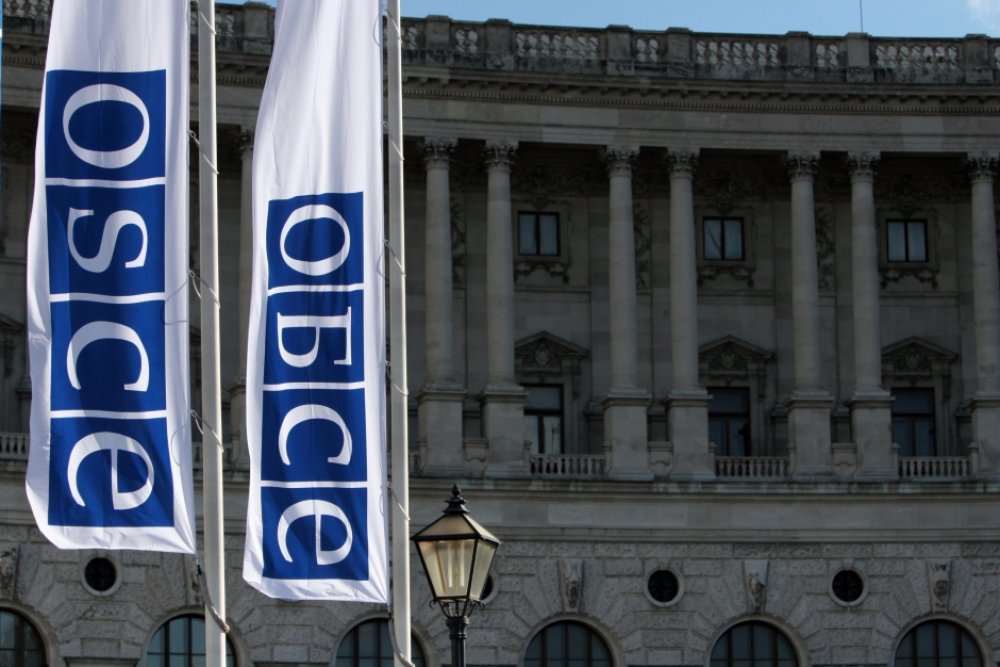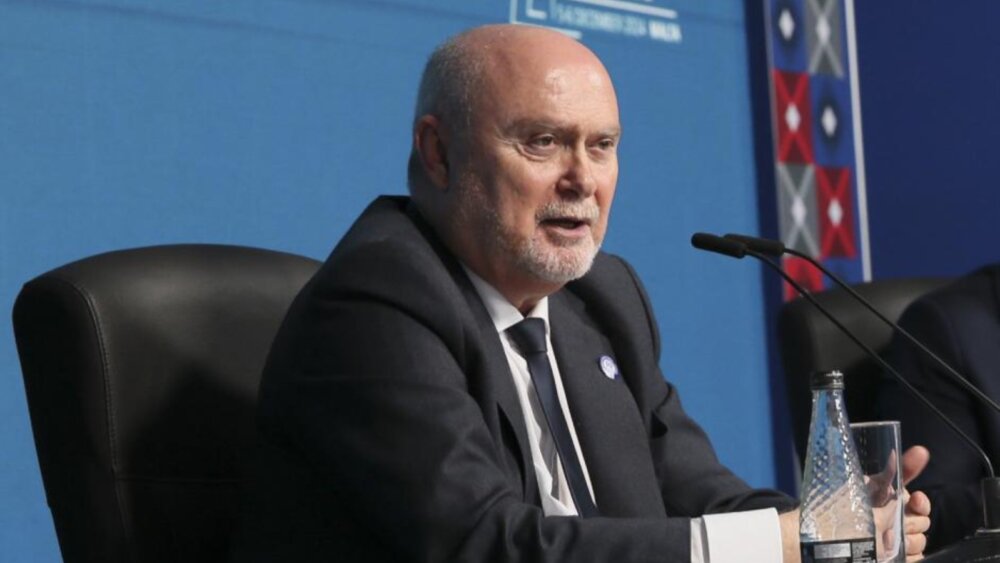OSCE

The Charter of Paris and the OSCE today
The Charter of Paris for a New Europe was adopted by Heads of State from Europe and North America at a time of immense optimism, as the forty-year division of Europe into two hostile camps was ending. The contents of the Charter constitute both an ending and a beginning. The normative sections of the document on human rights, democracy, economic liberty, international relations, and security mark the culmination of a fifteen-year process, beginning with the Helsinki Final Act, to reach agreement between East and West in the Euro-Atlantic area on fundamental values and rules of behavior both between and within states. The latter portions of the Charter are the beginning of a process, an effort to establish and develop institutions which would facilitate realization of the ideals and principles agreed in the first sections of the Charter.
High-water mark of political consensus
The Charter of Paris is a remarkable document, with unequivocal statements of principle which are a rarity in the history of diplomacy and international relations. As such, the document is a distillation and representation of the rare sense of relief, unity, and comity among the states of Europe and North America at the end of a conflict dividing the continent and lasting over forty years.
The Charter reflects the great enthusiasm and optimism of the time. Although they could not specify exactly how, the leaders who signed the document expected that life would be better in the future than it had been during decades of Cold War. All in all, the Charter of Paris – and the other landmark agreements reached in the period 1989-1991 – represents the high-water mark of political consensus among the major European powers for at least the past century and a half.
The Paris Summit of November 1990 began the institutionalization of the CSCE, the transformation of a roving diplomatic conclave into a comprehensive regional international organization. Building the major elements of the OSCE took the better part of a decade, and the process of institutionalization continues to this day.
While there was broad agreement among the CSCE participating States in November 1990 on the normative portions of the Paris Charter, there were fundamental differences from the very beginning among the major powers over the structure and powers of the OSCE and its role in the broader European security architecture. These differences were not the result of lingering rivalries or malign geopolitical ambition, but rather the product of genuine, fundamentally different visions of how peace and security in Europe could best be maintained.
Russian leaders generally desired that the pan-European security process, the CSCE, should replace the system of rival alliances that had dominated Europe for almost a half-century. Thus, the idea of the OSCE as a regional organization under Chapter VIII of the UN Charter was particularly appealing to Moscow.
However, at the same time as the initial steps were made toward institutionalizing the CSCE, western European leaders in the European Community were taking a key step in the process of European integration by adopting the Maastricht Treaty and creating the European Union. And in Washington, U.S. leaders were contemplating how to preserve and transform NATO as the best way to ensure military security for Europe and maintain a U.S. security and political presence on the continent.
Differing visions of the European security architecture
As one reads today the private thoughts and public statements of the leaders of that time, two things seem clear. First, most of those leaders approached the process of transforming Europe in a cooperative, forward-looking fashion. Of course, there were exceptions to this pattern, but they did not generally determine the policy of major states.
Second, through most of the 1990s, most of the leaders in Europe and North America believed or hoped that the differing visions of the European security architecture could be reconciled. In the end, as much because of events as from intentions, these expectations proved to be an error. By the time of the 2013 Ukraine crisis, Russia’s discontent with perceived structural inequities of the European security architecture led to a rupture of the post-Cold War order, and the bitter disputes that divide Europe to this day.
The approach to the European security architecture developed in the 1990s by the United States and its major allies envisioned a set of interlocking, overlapping, cooperative security institutions, with an agreed division of labor, distribution of tasks, and specialization. This vision of European security called in principle for integration of Russia into these structures. However, the manner in which the security architecture developed in practice, in particular EU and NATO expansion, produced a system in which the OSCE was marginalized and Russia effectively excluded from full participation. By the early to mid-2000s one was already hearing complaints to this effect from Russian officials and representatives.
After both participating in and studying the development of this post-Cold War European security order, I do not believe that this result – the effective sidelining or exclusion of Russia – was intentional, at least on the part of most western officials and leaders. Short-term, urgent responses to crises such as the disintegration of Yugoslavia and the wars in Bosnia and Croatia, played a major role in shaping the development of European institutions in ways that simply were not envisioned or anticipated when the Charter of Paris was adopted.
The U.S.-led global war on terror after 2001 played a further crucial role in moving NATO and other institutions in directions that European leaders in 1990 simply did not consider. Relations between Russia and some of its immediate neighbors, former republics of the Soviet Union, became an increasing source of tension between East and West, reflecting deep differences over the independence, sovereignty, and geopolitical orientation of these countries.
Bitter divisions once again
The process of these momentous changes was gradual and incremental, but by 2014 the result was clear and stark – Europe was once again bitterly divided between East and West. It took me a 400-page book (No Place for Russia: European Security Institutions Since 1989, 2018) to try to describe and explain how the optimism of 1989 was transformed into the harsh reality of 2014.
Thus, I am sure that this article in no way fully and adequately explains how we got to where we are today. The main point to keep in mind is that, while the result may have been originally unintended, today’s divisions and resentments are very real and deep. For those actively involved in the OSCE, the task now must be not only to explain, but to repair the damage.
There are obviously things that NATO, the EU, and Russia need to do in order to restore the relationships between them. For purposes of this article I will concentrate on the OSCE, which remains the only comprehensive European security institution in which the U.S., other NATO states, EU member states, and Russia meet on an equal footing. This quality is the main advantage of the OSCE: it is the security forum in which all European and the two major North American states are automatically included.
The OSCE: a reflection of international relations
The OSCE’s flaws and weaknesses, on the other hand, have been demonstrated repeatedly over at least the past two decades. The Organization’s major deliberative body, the Permanent Council, is often little more than a theater for orchestrated political denunciations to be exchanged between participating States.
Despite numerous field and mediation missions, the Organization has yet to achieve settlement of any major conflict in the OSCE area. In summer 2020, the Organization could not agree on the reappointment of four of its most senior officials. Overall, critics claim that adherence to the consensus rule paralyzes the Organization and prevents it from taking any significant decisions or actions.
These and other, similar criticisms identify all the trees but miss the forest. The OSCE, like any multilateral international organization, simply reflects the state of relations among the nations that make up its membership. When relations are good or most of the member states are like-minded, the organization works well. When relations are bad and there are major disagreements among members, that same organization will not function. Those who criticize the present-day OSCE should keep in mind that for most of its fifteen-year history before the Charter of Paris, the CSCE found it extremely difficult to agree on anything. Progress was incremental and laborious, concessions few and grudging, and consensus mostly absent.
The history of the CSCE from its beginnings to the Charter of Paris is proof that great things can be envisioned and accomplished even during times of great international discord and instability, such as the final decade and a half of the Cold War. During such times one must make a realistic assessment of what one may reasonably expect to accomplish in the near term, and leave broader goals as eventual aspirations.
Political leaders, officials, and diplomats also need to commit themselves and the states they represent to a process aimed at eventual improvement, without demanding immediate results as the price of their participation. That kind of situation, which some of us experienced in the 1970s and 80s, I believe, is where the Euro-Atlantic community finds itself right now.
So, what can and should the OSCE do now?
• First of all, the participating States need to re-commit to continued participation in and support for the Organization. Thirty years after the Paris Summit, the OSCE has a substantial institutional structure, with far-reaching capabilities. Like the United Nations during much of its history, even if the OSCE States cannot agree on major political issues, the technical agencies or institutions can still do a great deal of useful work. While they continue to argue about great geopolitical issues, OSCE States should ensure that this routine but valuable work continues to get done.
• Second, issues of military security and stability need to be addressed. The structure of conventional arms control launched in Paris in November 1990 is not only largely gone, along with the Treaty on Conventional Armed Forces in Europe (CFE Treaty), but also obsolete. However, the basic principles behind any arms control regime – transparency, confidence-building, and reducing the fear of surprise attack – remain valid. The 2011 Vienna Document (VDOC) needs to be updated, and if possible, its transparency provisions expanded. In addition, a new dialogue needs to be launched on conventional security and stability in Europe which will take into account advances in military and other technologies since the early 1990s. The OSCE structured dialogue seems to me to present an ideal forum for such a dialogue. If some larger participating States prefer a smaller format to begin such a dialogue, the example of the limited-participation CFE talks in the broader context of the CSCE might serve as a model.
• Third, ODIHR and the Office of the Representative on Freedom of the Media should launch an examination of the implications and effects of the communications, internet, and social media revolutions on the conduct of free elections, including election campaigns. Such an effort should be open to the participation of technical and government representatives of all interested participating States. I would expect such an effort at the outset to reflect great disagreement among the participating States, but I believe it could lead eventually to greater understanding and perhaps even some new, agreed norms. In essence, this is a new basket, or sub-basket, which did not exist in 1973, but which needs to be talked about today.
• Fourth, enough time has passed and enough experience accumulated that it would probably be useful to have a comprehensive overall assessment of what has worked and what has not in the system of OSCE field missions. This assessment should be done with a view both to changing and improving existing field missions and to establishing and deploying possible future field operations. This exercise could be accomplished either by a representative “wise man” exercise or through the OSCE network of think tanks. One might aim toward a report and a high-level affirmation of the continuing value of OSCE field operations during the Organization’s fiftieth anniversary in 2025.
• Finally, consensus. Many critics say eliminate the requirement and the Organization will work better. I reply with a misquote of Shakespeare: “the fault is not in consensus, but in ourselves.” Or as one U.S. diplomat wryly remarked to me: “Both the U.S. and Russia would agree to eliminating consensus until the first majority vote went against them.” It might be possible to allow certain technical and administrative decisions in the OSCE, both in the Secretariat and in the Institutions, to be made via qualified majority, and it is probably worth investigating the possibility of such a reform. But for major issues, the OSCE is stuck with consensus. We all will just have to live with that, as we have for the past forty-five years.
Threshold of a new order
With the OSCE in such disarray and with Europe so divided, is the Charter of Paris still relevant thirty years later? My answer is yes; the document expresses principles and norms of behavior to which we all should continue to aspire. It also stands as a lasting example of what States and leaders can accomplish through persistent, focused, common effort.
The political and security order that prevailed in Europe and North America for twenty-five years after the Paris Charter has collapsed. We stand on the threshold of a new order, not yet knowing what its features will be. The OSCE and its participating states have a choice – allow the Organization to deteriorate along with the rest of the old order, or to adapt, reform, and rebuild. I hope we choose the latter.
*Dr. William H. Hill is a retired U.S. career diplomat and a former Professor of National Security Strategy at the National War College of the National Defense University in Washington, DC. Dr. Hill is an expert on Russia and the former Soviet Union, East– West relations, and European multilateral diplomacy. In his capacity as U.S. ambassador, he served two terms (2003–2006 and 1999–2001) as Head of the OSCE Mission to Moldova, where he was charged with negotiating a political settlement of the Transdniestrian conflict and with facilitating the withdrawal of Russian forces, arms, and ammunition from Moldova. He is currently a Global Fellow at the Woodrow Wilson International Centre for Scholars in Washington, DC. Dr. Hill is the author of the recently published book No Place for Russia: European Security Institutions Since 1989.
This article was prepared by the author for the virtual roundtable discussion on the topic “30 years Charter of Paris: Lessons for pragmatic cooperation in the OSCE area”, organized by the German Foreign Office and the Institute for Peace Research and Security Policy/University of Hamburg, and held on 8 September. The author was a speaker at the online conference.



Comments
* Your email address will not be published